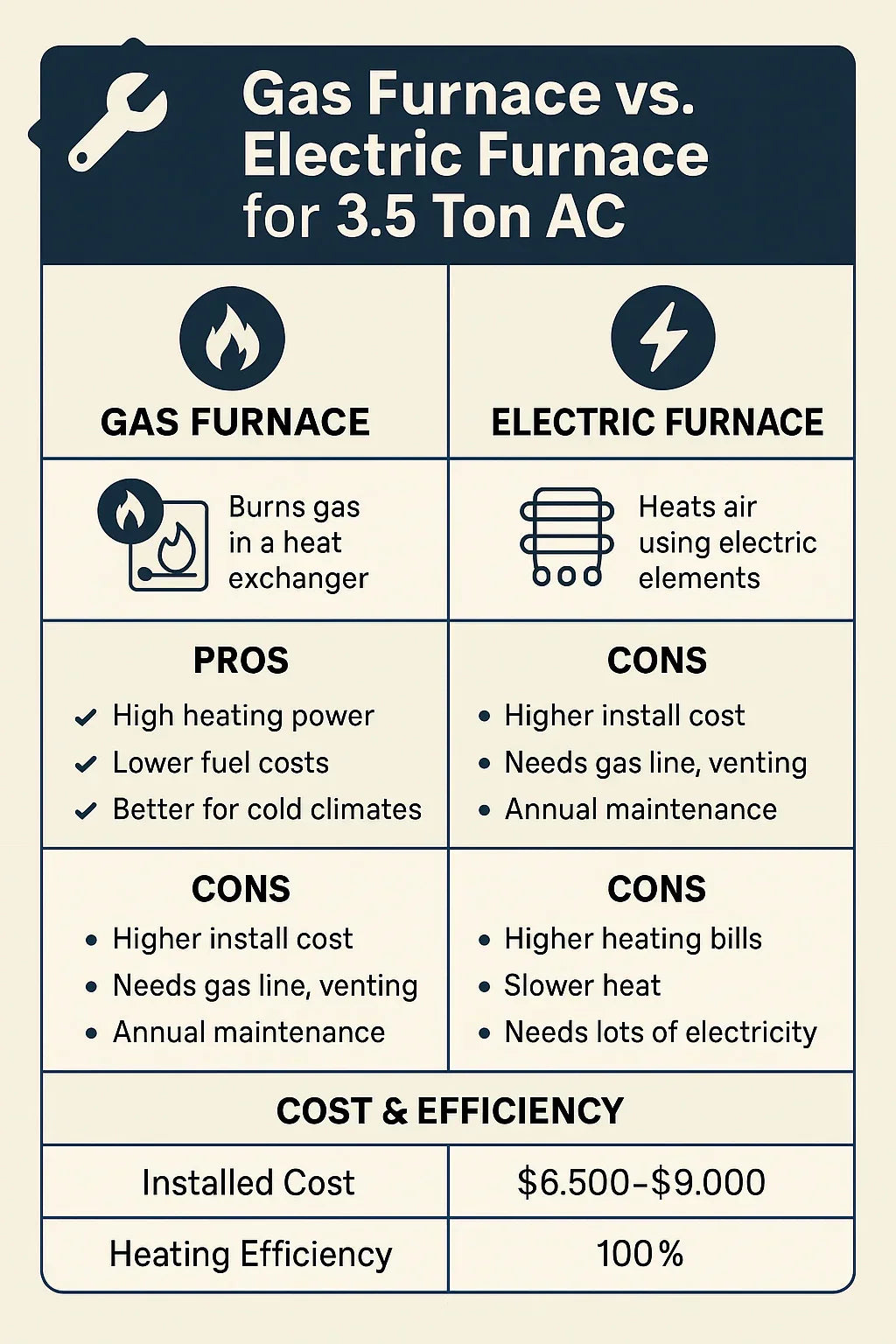🌟 Introduction: Why Furnace Type Matters in a 3.5 Ton AC System
When homeowners talk about buying a 3.5 ton air conditioner, they often focus on cooling performance and efficiency. But if you’re getting a full HVAC system, the furnace you choose to pair with it can have a huge impact on comfort, efficiency, and long-term operating costs.
Your two main options:
-
Gas Furnace — Powered by natural gas or propane.
-
Electric Furnace — Uses electric resistance heating.
While both can deliver warm air through the same ductwork your AC uses, they differ in cost, performance, installation requirements, and best-use scenarios. I’m going to walk you through exactly how each works, the pros and cons, efficiency numbers, and my 2025 recommendations for different climates and budgets.
🔥 How a Gas Furnace Works with a 3.5 Ton AC
A gas furnace burns natural gas (or propane) in a heat exchanger, and a blower pushes the heated air through your ducts. In a combined AC/furnace system, the blower also circulates cool air in summer.
Key Points:
-
Requires a gas line connection or propane tank.
-
Needs venting (chimney or PVC pipe) to expel combustion gases.
-
Compatible with any 3.5 ton AC coil, as long as airflow and capacity match.
Pros:
-
✅ High heating power — ideal for cold climates.
-
✅ Lower heating costs in regions with affordable gas.
-
✅ Quick warm-up time.
-
✅ Durability — many last 15–20+ years with proper maintenance.
Cons:
-
❌ Higher install cost than electric.
-
❌ Requires gas infrastructure (may not be available everywhere).
-
❌ Produces combustion gases — requires safe venting and CO detectors.
-
❌ Annual maintenance needed for burners and heat exchanger.
⚡ How an Electric Furnace Works with a 3.5 Ton AC
An electric furnace uses resistance heating coils — think giant versions of toaster wires — to heat air, which the blower then circulates through your duct system.
Key Points:
-
Runs solely on electricity.
-
No venting needed (no combustion).
-
Works as an air handler for your AC in summer.
Pros:
-
✅ Lower upfront cost — especially for installation.
-
✅ No gas line or venting required.
-
✅ Low maintenance — no combustion parts to clean or inspect.
-
✅ Safe operation — no risk of gas leaks or CO poisoning.
Cons:
-
❌ Higher operating cost in most regions — electric resistance heat is expensive compared to natural gas.
-
❌ Slower heating than gas.
-
❌ Can strain electrical service — may require panel upgrade.
-
❌ Less efficient in cold climates unless paired with a heat pump.
📊 Efficiency Ratings Explained
Gas Furnace Efficiency – AFUE
-
AFUE (Annual Fuel Utilization Efficiency) measures how much fuel is converted to usable heat.
-
80% AFUE: Standard efficiency — 80% of fuel becomes heat.
-
95–98% AFUE: High efficiency — nearly all fuel becomes heat.
Electric Furnace Efficiency
-
Technically 100% efficient at converting electricity into heat — but because electricity is more expensive per BTU than gas in most regions, the real-world cost efficiency is often worse.
SEER2 & Furnace Blowers
-
The blower motor in your furnace also affects AC efficiency.
-
ECM variable-speed blowers use less electricity and can boost SEER2 ratings in summer.
💲 Cost Comparison (2025 Data)
| System Type | Equipment Only | Installed (Typical) | Avg. Annual Operating Cost* |
|---|---|---|---|
| Gas Furnace (80% AFUE) + 3.5 Ton AC | $2,800 – $4,500 | $7,500 – $10,000 | $700 – $1,200 |
| Gas Furnace (95%+ AFUE) + 3.5 Ton AC | $3,200 – $5,200 | $8,500 – $11,500 | $600 – $1,100 |
| Electric Furnace + 3.5 Ton AC | $2,200 – $3,800 | $6,500 – $9,000 | $1,200 – $2,500 |
*Operating cost estimates assume 2,000 sq. ft. home, average insulation, and standard energy rates for 2025.
🌎 Climate-Based Recommendations
Cold Climates (Northern U.S., Canada)
-
Best choice: Gas furnace, preferably high-efficiency (95%+ AFUE).
-
Reason: Lower heating bills, faster warm-up in sub-zero temps.
Mild Climates (South, Southwest)
-
Best choice: Electric furnace — lower install cost, shorter heating season keeps operating costs manageable.
Areas with High Electric Rates
-
Gas furnace almost always cheaper to operate.
Areas with No Gas Infrastructure
-
Electric furnace is the default, unless you opt for a heat pump instead.
🛠 Maintenance & Lifespan
Gas Furnace Maintenance:
-
Annual inspection and cleaning of burners and heat exchanger.
-
Check CO detectors regularly.
-
Lifespan: 15–20 years (high-quality models can last longer).
Electric Furnace Maintenance:
-
Periodic dust/coil cleaning.
-
Inspect wiring and heating elements every few years.
-
Lifespan: 20–30 years (fewer moving parts).
📌 Mark’s Decision Matrix
| Priority | Best Choice | Why |
|---|---|---|
| Lowest Upfront Cost | Electric Furnace | No venting/gas line needed. |
| Lowest Operating Cost | Gas Furnace | Cheaper fuel in most areas. |
| Best for Cold Winters | Gas Furnace | More powerful, efficient heating. |
| Best for All-Electric Homes | Electric Furnace | Simplifies utility setup. |
| Longest Lifespan | Electric Furnace | Minimal moving/combustion parts. |
📎 Verified External References
✅ Conclusion
In 2025, the decision between a gas furnace and an electric furnace for your 3.5 ton AC system really comes down to:
-
Your climate
-
Your energy rates
-
Your home’s infrastructure
If you live in a cold climate with access to natural gas, a high-efficiency gas furnace will deliver better comfort and lower bills.
If you’re in a mild climate or an all-electric home, an electric furnace can be a cost-effective, low-maintenance choice.
In the next topic we will read more about: R-32 vs. R-410A Refrigerant in 3.5 Ton Systems: What’s Better for Your Home and the Environment?







